
250 people were arrested and dozens injured as Miami police used concussion grenades, taser guns, rubber bullets and tear gas on people demonstrating against the free trade talks. We speak with Jeremy Scahill and Ana Nogueira who was arrested for allegedly failing to disperse as well as former California state representative Tom Hayden who brought his Harvard students to the protests. [Includes transcript]
Some 250 arrests were made at demonstrations in Miami against the Free Trade Area of the Americas ministerial meeting last week. The talks ended Thursday, a day early, after ministers from 34 countries accepted a watered-down proposal in order to save the free trade talks from total collapse.
In an extraordinary display of police force and brutality, some 2,500 police officers deployed in the streets of Miami fired rubber bullets and tear gas at demonstrators. Scores of people were injured as police used both concussion grenades and stun guns on protesters. Miami Police Chief John Timoney, defended the officers’ approach, saying, “We are very proud of the police officers and their restraint. Lots of objects were thrown at the police officers.”
On Friday, as a group of demonstrators gathered outside a jail to protest the arrest of their colleagues, they in turn were arrested shortly afterwards for allegedly defying police orders to disperse. One of those arrested was Democracy Now! producer Ana Nogueira who was covering the protests with Jeremy Scahill, who earlier was shot with rubber bullets by Miami police.
- Ana Nogueira, Democracy Now! producer. She was arrested over the weekend by Miami police.
- Jeremy Scahill, Democracy Now! producer/correspondent. He was shot twice with rubber bullets as he reported on the protests.
- Tom Hayden, former State Representative in California and a longtime movement activist. He is a fellow at the Institute of Politics at Harvard University. He brought his students to the protests in Miami.
Transcript
AMY GOODMAN:Welcome back, first of all, Jeremy and Ana.
ANA NOGUEIRA AND JEREMY SCAHILL: Thank you.
AMY GOODMAN: Ana, why don’t you describe what happened. I think the story of what happened to you tells a lot about police conduct and also about how journalists were treated in Miami.
ANA NOGUEIRA: Right. Well, I was at a jail solidarity protest on Friday afternoon, probably with about 200 other folks and they — it was a very peaceful protest. People were in the parking lot, not even on the sidewalk, chanting, singing songs, “free the prisoner, not free trade.” We were totally surrounded by riot cops and we were eventually given an order to disperse and people decided they did not want to be arrested so they started walking away. And I was walking away with them when the cops started coming up behind us and eventually, you know, people stopped and turned around and said, put your guns down, we are dispersing as they are walking backwards. And they started getting surrounded on the streets and, again, they were given another orders to disperse, which they did. They walked on to the sidewalk and started walking away when a line of riot cops cut them off and I was trying to get past them, but they cut us off, surrounded us and pushed us into a corner very violently. People were falling over each other. They were beating people with batons and they pushed us up against a fence. My camera was knocked around and they started — they pulled out the pepper spray and knocked us down to the ground and beat people.
AMY GOODMAN: Were you wearing your press ID?
ANA NOGUEIRA: I was wearing my press ID, and I had my camera and they pretty much left me alone, even though they were pushing us around a lot. They did not spray me directly. They sprayed my clothes but not my face, like they did with other protesters. They weren’t pushing me down onto the ground as hard as they were pushing other protesters down. But they forced us against a fence, a chain-link fence and push so hard that the fence came down and we fall on top of each other and, again, they pulled out the pepper spray and they were kind of playing cat and mouse with us. They would tell us to get up and walk away and then push us down to the ground again and then get up and walk away and push us down. Eventually they arrested us one by one. Again, as I said, they didn’t know what to do with me. One officer seemed uncertain as to whether he should arrest me or not until the other officers around him said she’s not with us, she’s not with us, and they immediately arrested me.
AMY GOODMAN: What does that is mean?
ANA NOGUEIRA: It could mean one of two things. It’s either that I’m not an undercover police officer with the protesters using a camera because it certainly seemed that there were some of those around. And actually I have some footage of them with the cops earlier on but — or it could mean I’m not embedded with the police department. there were embedded reporters who had almost full-on riot gear on as well and I believe Jeremy witnessed an occasion where an embedded reporter even hit a protester himself.
AMY GOODMAN: Well, let’s talk about this. This is very serious issue. Again, not talk about reporters embedded in the front lines in the troops in Iraq, but now adopting that policy, both, we see the militarization of police and the same policies that the military uses with reporters. I guess it worked very well in Iraq. Jeremy, can you talk about this process of — and it may surprise many right now to hear — they’re actually talking about and practiced in Miami, embedding of reporters in the police department.
JEREMY SCAHILL: That’s right and actually I tried to determine how many reporters actually were embedded with the police and no one — none of the police spokespeople —-would acknowledge even that there was an embedding process. I was inquiring about this during the course of trying to get Ana out of jail because I spent so much time dealing with the police on this issue. There were several things that happened that I think need to be noted. One is, as Ana mentioned, a photographer for the “Miami Herald,” who was embedded with the -— it’s hard to call them police — I would say soldiers that were in the streets of Miami. And in fact, a lot of the budget for Miami came from this $8.5 million that was allocated to Miami from the $87 billion Iraq spending bill. But a “Miami Herald” photographer got separated from his unit in the Miami police department and ended up on the dangerous side of the lines with the unarmed protesters and he did not like the fact that kids in the protest had locked arms and were essentially trying to hold the line outside of the inner continental hotel where the FTAA ministerial talks were happening. Protesters were right near there and he was furious that he had gotten separated, was trying to get back through and the kids just wouldn’t move out of the way.
The kids said, no, these are our streets and we’re staying here and the “Miami Herald” photographer just starts hitting a kid in the back of his head, like punching him. You know, we were filming. I was there with John Hamilton from the “Worker’s Independent News Service” and we were filming this and the kid kind of turns around and pushes the guy and says, back off. And the guy had to be restrained by his colleagues because he was going to go ballistic on demonstrators that he was supposed to be covering. The other thing is while the reporters were being embedded with the Miami military, you also had the Miami military embedding people with the protesters. Not many journalists were embedded with the protesters, but they have had undercover police officers, agent provocateurs with the protesters and the reason we know this is because of one particular incident that many people witnessed and that was a scuffle broke out and appeared to be a scuffle between protesters and there was about four or five people involved. One of the —-what looked like a protester was hitting another and so people moved in and tried to pull them off at which point this person who appeared to be a protester pulled out a taser gun and started tasering the other protesters. Then he was liberated by the police and brought to the other side of police lines. Now, some of these people even had backpacks on with sayings that said, “no way FTAA,” and ”FTAA sucks.” So these are the kinds of tactics that were being used in Miami. We had in incident were chief Timoney himself -— and of course he is well known to listeners of this show because he was the police commissioner in Philadelphia during the convention where there was brutality against protesters on the streets — he approached us on a bicycle, when we were with Norm Stockwell from WORT. We were getting into the car and Timoney speeds over on his bicycle with his men and they’re saying, give us the license and registration and, you know, everyone was cooperating and then, you know, Timoney speeds away and the whole thing was filmed. It was like a propaganda film for Timoney. And then one of them comes up to us and he was wearing ago Miami PD polo shirt with a bike helmet like the bike cops and comes up and says, can I have your name? And I’m looking and I see that he has this polo shirt on, but then I also realize he has as “Miami Herald” press pass on and of course he was an embedded journalist. But you would think he was police officer from how he was dressed and how he was acting.
AMY GOODMAN: Well, we have to break for stations to identify themselves. When we come back, Jeremy Scahill and Ana Nogueira will be joined by Tom Hayden, who was also in the streets. He was there with a group of Harvard students, most of whom got arrested. Stay with us.
AMY GOODMAN: I’m Amy Goodman joined by my colleagues, Jeremy Scahill, and Ana Nogueira. She was arrested on Friday, got out in the early hours of Saturday, and Jeremy was shot with rubber bullets. On the phone with us, Tom Hayden at the institute of politics at Harvard university, formerly state senator in California, one of the founding members many years ago of S.D.S., Students for a Democratic Society in the 1960’s. Tom Hayden, this issue of the millitarization of police, you were in Cancun, you were at FTAA in Miami. What are you seeing here?
TOM HAYDEN: Well, first of all, good morning and I was in an eyewitness to Ana and the Harvard students and to the undercover agent who switched gear in clothes that Jeremy described, and there was a pattern and the difference between Cancun and Miami was this, that in Cancun at the W.T.O. protests, the Mexican government, Mexican police deliberately deescalated the violence that could have been inflicted on protesters. There was virtually no beatings. there was some jostling. There was some confrontation. There was no gassing. There was no significant arrests. Civil disobedience in the street, blocked traffic, and yet an exit strategy was negotiated with the protesters with mutual respect. They were given buses to go back to their campgrounds and so on and so forth. So, it shows that it’s not inevitable or necessary that the state react with this kind of militarized response. And representative of the Miami police department were there observing it so they knew this. The F.B.I. was there, they knew this. So it has to be for political reasons that the state has chosen this kind of militarization. you see the “New York Times” story, of course, yesterday that showed further corroboration that the F.B.I. is involved in coordinating this kind of surveillance of so-called extremists and I think it is a frightening development. I think that the Miami mod is more likely to be used because it’s apparently good politics for the Bush brothers. It’s certainly good politics for police because there is an open supply line of money from Iraq that is now diverted to the Miami police. And unless liberals stand up more than they have and see what’s going on, I suspect this is going to be the path of the future.
AMY GOODMAN: What happened to the students you were with, Tom Hayden?
TOM HAYDEN: It was just as Ana described. They were observing and they obeyed an order to disperse. They got caught in a situation where anyone in their shoes would have done the same thing. They walked backwards because it was — the police display was very frightening. Along with 20 or 30 other people, they raised their hands to show that they had no weapons, no rocks. They chanted “We are dispersing. We are dispersing. We are dispersing” The police ordered them to get on the sidewalk. Out of the street. They complied. They got on the sidewalk. “We are dispersing. We are dispersing.” And then they were arrested apparently for not dispersing properly. I don’t know why. It will never holds up barf jury and I’m sure it will never go to court. But when you get to the point of repressing people who are obeying your own order to disperse because use don’t like the way they are dispersing, I mean, for heaven’s sake, they were dispersing this way because they had good reason to be afraid because if they ran or turned their backs they could be shot with rubber or plastic bullets because it happened repeatedly. They were just at a press conference where people showed their wounds.
The police eventually allowed no avenue for dispersal. That is the main point. They cordoned off the point of people dispersing and then they either fell through that fence or they lay down on the fence or they lay down or both. Two of my students who were on the ground said they still didn’t think they were being arrested. They just though it was some kind of accident until they were cuffed and pepper sprayed.
AMY GOODMAN: In fact, we’re talking about Friday. This is when most people — weren’t they going home?
JEREMY SCAHILL: A lot of people had started to go home or move towards Georgia to go to the school of the Americas protest. But also that is exactly when the police choose to be their most brutal is when, the cameras start to go and the crowds start to get a little bit thinner. Look, when major union rally ended that had a legal permit of it, that’s when the brutality hit. As soon as the unions and their legal permits left, that’s when the police started to indiscriminately fire on crowds outside the Intercontinental Hotel. That’s when I got hit twice. John Hamilton who was working with us got hit in his neck with a pepper spray pellet that exploded into a white powder over the side of his face and began burning him. This is when they choose, the police choose, to be their most brutal, when the cameras go and the big crowds are gone. They like to catch small groups of people in corners and go after them and attack them. One point, i think it’s important to make, that so much of the media coverage coming out of this — and there wasn’t much media coverage — was focused on the police verses the protesters and this was really a distraction to the much bigger issue. The reason why tens of thousands of people came to Miami was to protest against the ministerial talks of the Free Trade Area of the Americas. And what most people were saying is, look, we’re here because we’re here to protest the hidden hand of the free market and the iron fist of militarism. We are here because we don’t want an expansion of NAFTA in the himself fear. We’re here because almost every government in this hemisphere is against this kind of agreement that the U.S. Is trying to push through. These institutions the W.T.O., the FTAA are on the run right now from international protest and uprising. They can’t hold a meeting without having massive protest. They constantly have to shut them down early, cancel them, the talks fell apart. And Zoellick, the U.S. Trade representative was trying his bests to spin that this was a victory for the U.S. When, in reality, the U.S. Was forced to go into numerous bilateral sessions with countries because they couldn’t get a comprehensive agreement. No one in this hemisphere except the U.S., Canada and perhaps Mexico wants an expansion of NAFTA.
TOM HAYDEN: Amy?
AMY GOODMAN: Yes, Tom Hayden.
TOM HAYDEN: What happened on the inside was that they still have been staggered by the derailing of the W.T.O. at Cancun. They were deathly afraid on the American side that this would collapse, these talks would collapse and it would be an embarrassment for Bush going into the election year. So, they patched together an amazing agreement between the United States and Brazil, who are the co-chairs, Brazil having an abiding interest in stopping the agricultural subsidies on the American side. And the agreement was to agree to disagree. They met on Thursday and they took most of the time on diverse — this is according to the inside accounts, they took most of the time on diversionary inside reports by outside experts on trade arcania and they had lunch and then they did it again and not only 3:45 or 4:00 on Thursday did somebody say, well, let’s take up this report and then Venezuela made a comment about how the report was insufficient. And then there was a little buzzing and they retired for the night. That was it. There was no serious discussion of it. Except to say that the report was accepted and then they announced they were going home the next day. So, the report is being trumpeted as a victory by the United States and no one else. Canada and Mexico are partners in NAFTA, were not happy with it. The Latin American countries were not happy with it. Above all the Chamber of Commerce, the U.S. Chamber of Commerce was very unhappy with it because it kind of dilutes trade back down to a modest subject, rather than an expansion of corporate investment rights and that was the end of it. It was over a day early. They have had done nothing, except have a public relations ceremony announcing that they had completed their negotiations.
AMY GOODMAN: I want to talk about the precedent set here. The New York Civil Liberties Union has filed three federal lawsuits claiming that the city’s police tactics during protests are unconstitutional and will hinder the right to demonstrate during next year’s republican national convention. The NYCLU is dealing with the February 15 anti-war rally that drew something like half a million people, the group saying police blocked access to demonstrators in some areas and controlled crowds with some force. Timoney once in Philadelphia, now in Miami, are we seeing that happening?
TOM HAYDEN: Well, you in New York better get ready. That’s all I can tell you. I mean, they seem to — the mayor of Miami called this a model for homeland defense. Now, allowing for a little P.R. hyperbole for Miami, that seems to be what the police strategies are based on. The dea is if there is a remotest possibility of anybody getting out of hand — and we’re not talking about car bombers here, we’re talking about people that might throw a tear gas canister back at police that have fired it at them, anybody that gets out of hand threat of that justifies a maximum response and politically they may be right. You know, the American people may be so frightened that they favor an excessive show of force for fear of what might happen if there isn’t. So, the Democrats, the Greens, the radicals, the liberals of the left, the media have got to focus on this because this is the way a highly repressive apparatus gets installed. That’s what’s happening here. and it’s virtually national because it is coordinated by Ashcroft’s justice department and funded by the Iraq money.
ANA NOGUEIRA: I just want to remind people that there are 15 people facing felony charges in Miami and if you remember from the Republican National Convention, the people charged with felonies who were people who were beaten unconscious by the police. Basically the police have projected on to the protesters the actions and the illegal actions that they themselves commit. And people should not be — I mean, they are trying to intimidate the protesters and the movement into basically shutting up about all these trade deals and militarization. But we can fight these felony charges and people should fight these felony charges can and be sure to still make your voices heard and be here for the Republican national convention.
AMY GOODMAN: Well, I want to thank you both very much, Ana and Jeremy. I didn’t think that covering issues like these meant risking your lives or your freedom, but it does look like that today. Democrat Now! Producers were in Miami. Tom Hayden was on the streets as well. His piece “Arresting the Future” has been put out by AlterNet. He is now at the Institute for Politics in Boston at Harvard University.

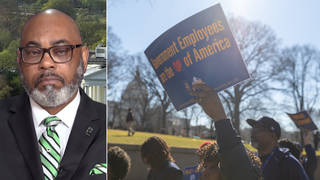
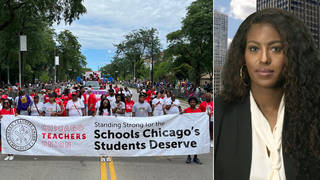
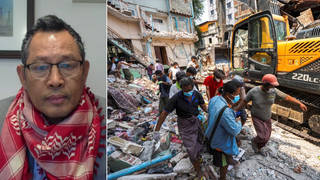
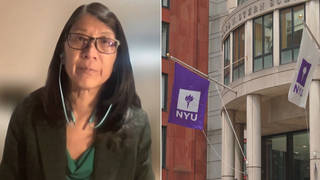





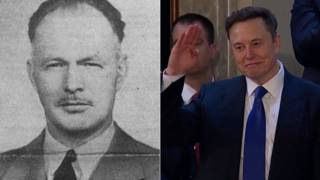
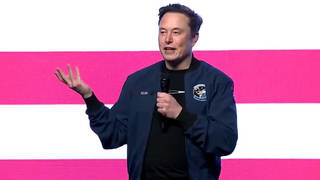
Media Options